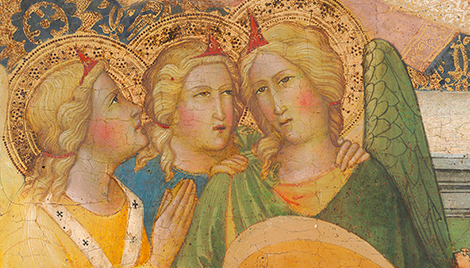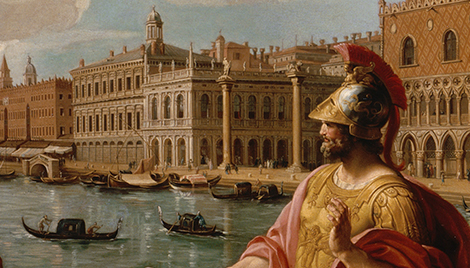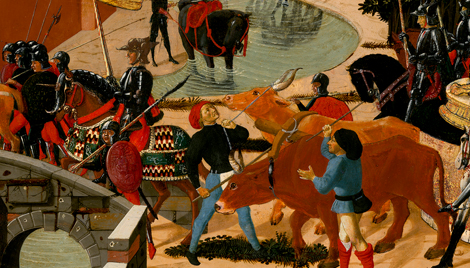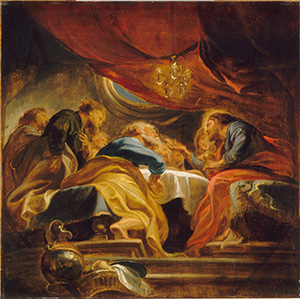The Last Supper
The Last Supper
- Artist
- Sir Peter Paul Rubens
- Artist Dates
- 1577-1640
- Artist Nationality
- Flemish
- Title
- The Last Supper
- Date
- 1620-21
- Medium
- oil on panel
- Dimensions
- 43.5 x 43.9 cm (17-1/8 x 17-1/4 in)
- K Number
- K1997
- Repository
- Seattle Art Museum
- Accession Number
- 61.166
- Notes
Provenance
Possibly Victor Wolfvoet, Antwerp, Belgium [1612-1652]. Possibly Simon de Vos [1603-1676] sold 16 June 1662 to Guillam I Forchoudt. Jacques de Roore [1686-1747]; (his sale, Verheyden, The Hague, 4 September 1747,no. 45, sold with six other modelli from series); Anthonis and Stephanus de Groot; (Groot sale, Rietmudler, The Hague, 20 March 1771, no. 4, sold with other modelli from series). (Abelsz). Jacques Clemens; (his sale, Gent, 21 June 1779, no. 232). (sale, Schley et. al., Amsterdam, 19 September 1798, no. 150, bought in). [1] (Sale, Geens, Brussels, 25 August 1814, no. 108). Robert de Saint-Victor, Rouen; (his sale, Roux, Paris, 26 November 1822, no. 29); (Roux). Marquise d'Aoust; (his sale, Galerie George Petit, Paris, 5 June 1924, no. 78); Francesco Gentili di Giuseppe, Paris [d. 1940]; to his daughter, Mrs. A. Salem, Boston, until 1950; (Frederick Mont, Inc. and Newhouse Galleries); sold to the Samuel H. Kress Foundation on 25 January 1954; gift 1961 to the Seattle Art Museum, no. 61.166. [1] Sources vary as to whether this lot in the anonymous sale was consigned by Barchman Wuytiers, Brussels or Supertini and Platina, Brussels. The lot was consigned by "F."
Catalogue Entry
Sir Peter Paul Rubens
The Last Supper
K1997
Seattle, Washington, Seattle Art Museum (F37/R8230.1), since 1954. Oil on oak. 17 1/8 x 17 1/4 in. (43.5 x 43.9 cm.). A strip about 2 1/6 inches high was added to the top of the panel, probably early in the nineteenth century. Great care was taken to use wood of a matching grain. The original panel was almost square; the lines cutting diagonally across the comers may have been impressed from an old frame.(1) Cradled at unknown date. Vertical split to the left of wrist of Christ's outstretched hand. Small splits at upper left. Generally well preserved. Last cleaned c. 1945. Varnished by Modestini in 1954. Seattle, 1954, p. 60. Reproduced in color, Life Magazine, LII, 7, 19 Feb. 1962, p. 56. Christ in a blue tunic and a rose-red mantle is seated at the extreme right. He holds the golden chalice with his left hand, extending the bread with his right. The young St. John the Evangelist is at Christ's right. St. Peter, in the foreground in blue with a yellow-gold mantle, leans toward Christ; a half-standing Apostle is at the left, his left hand on his breast; four additional Apostles are seen in the background. The violent gesticulation of the participants represents the Apostles' reaction to Christ's words that one of those assembled would betray him (Matthew 26:20-5; Mark 14:17-21; Luke 22:21-3; John 13:21-30). The steps leading up to the table may allude to altar steps. The uppermost section-the length of the hanging chain is a later addition. The Last Supper takes place at a table of circular Early Christian form, surrounded by benches, approached by steps, upon which, in the extreme foreground, a gilded ewer and covered bread basket are placed – symbols of the Eucharist.(2) The painting is a modello, a colored oil sketch for one of the thirty-nine ceiling paintings for the great Jesuit church of Antwerp.(3) Rubens was almost forty when he received the commission, the second of such size and complexity; it followed the Decius Mus tapestry cartoon series ordered c. 1617 (see K2117). Construction of the Antwerp Jesuit Church (in whose design Rubens may well have had an important role) began in 1615; it was completed in 1621. Rubens was first commissioned (c. 1616) to execute two canvases for the high altar (The Miracles of St. Ignatius Loyola; The Miracles of St. Francis Xavier, now Vienna, Kunsthistorisches Museum). On 29 March 1620, he contracted to design the ceiling paintings for the aisles and galleries. There were to be nine saints represented above each aisle and three over the entrance. Nine Old and New Testament subjects were painted for the galleries. For each of these Rubens probably painted a summary rendering or bozzetto (a grisaille-like sketch in brown with tones of white), followed by a relatively finished modello in color for submission to his patrons and for the guidance of the artists in his studio – most notably Anthony van Dyck who, according to the contract, were to execute the ceiling paintings. They were delivered and installed in 1621; each measured about 3 x 4.2 m. On 18 July 1718, the church was struck by lightning, and all the ceiling paintings were totally destroyed. Thirty-three preparatory studies by Rubens survive, covering twenty-three of the thirty-nine subjects. There are thirteen bozzetti and twenty modelli, as well as reproductive drawings and prints after the entire cycle.(4) Five eighteenth-century drawings after the lost painting of the Last Supper are known: C. B. Müller in Antwerp, Prentenkabinet (Martin, fig. 48; prepared six months before the fire); Jacob De Wit in London, British Museum (Martin, fig. 50); De Wit in Antwerp, Prentenkabinet (Martin, fig. 51); De Wit in London, collection of Count Antoine Seilern (Martin, p. 80). An anonymous British Museum drawing is the closest of all to K1997.(5) The lost ceiling painting based on K1997 was engraved by J.J. Preissler after De Wit (Martin, fig. 49) as an octagon inscribed in a square and by Jan Punt (Text Fig. 25) as an eight-sided figure in a rectangle. Martin cited the Last Supper illustration designed by Rubens for the Breviarium Romanum of 1614 as the artist's first depiction of the subject, and stressed the possible influence of the brilliant foreshortening in Giulio Romano's ceiling fresco of Psyche Served by Unseen Hands (Mantua, Palazzo del Tè), to explain the new sense of drama separating the work of 1614 from K1997, painted about six years later.(6) The Last Supper was one of six paintings whose theme was not specified in the original contract of 29 March 1620; as the subject is central to Christian doctrine, its depiction may have been assumed.(7) In addition to the Last Supper, the Adoration of the Magi and the Nativity, there are six subjects from the Old Testament in the north gallery. The south gallery had five New Testament and four Old Testament subjects. The Last Supper was placed next to a representation of Melchizedek offering bread and wine to Abraham, the prefiguration of the institution of the Eucharist at the Last Supper. The Biblical program with nine scenes from the Life of Christ and the Virgin, together with nine subjects from the Old Testament regarded as their prototypes, stems from late medieval sources – the Biblia pauperum and the Speculum humanae salvationis. By 1622 this relationship had already been set forth; the ceiling was described as 'adorned with noble pictures which either represent the mysteries of our salvation in parallel from the Old and New Testament, or show various personages both male and female, who are distinguished for their sanctity.'(8) According to Martin, 'Rubens has emphasized the mystical connection between the two subjects in several ways ... the wine-jar and the basket seen on the steps in the Last Supper resemble those in the Old Testament scene, and there is a covert allusion to the meeting of Abraham and Melchizedek in the attitudes of Peter and the Lord, who are seated facing each other.'(9) Copyists seem to have misunderstood the circular composition of the Last Supper. In reproductive prints the steps are squared off and the architecture changed, the oculus moved up so as to be almost parallel in plane with the table, unless Rubens himself made these alterations subsequent to his design (K1997). Judging by most copies, Rubens eliminated the heads of three Apostles shown just below the oculus, simplifying the composition to concentrate the drama on the foreground figures. Seen from below, the complex architectural setting suggests Rubens is following the Biblical specification that the Last Supper took place in an 'upper room' (Mark 14:12-16, Luke 22:7-13). The spatial indications point to a circular (domical?) chamber, this form repeated by the curved steps, the round table, and the oculus above, through which the blue sky can be seen. The somewhat ambiguous placement of the window points to Rubens's having had a Pantheon-like structure in mind with an opening to the heavens at the center of a dome.(10) The placement of the window was so shown in the print of 1752. At about the time Rubens painted the Kress panel, he was building his own house, which included a miniature Pantheon like the interior of K1997, to house his antiquities.(11) Rubens may have consulted Dürer's prints of the Last Supper, in which an oculus is on the wall behind Christ; a round table was shown in Dürer's Small Woodcut Passion Last Supper (B.24) and by Limosin.(12) Tintoretto, as well as Giulio Romano, probably played a role in shaping the composition of K1997. The placement of Christ at the extreme right and the elevation of the table upon steps is found in the Venetian master's Last Supper of c. 1580 (Venice, Santo Stefano),(13) Although recalling aspects of the art of Dürer, Giulio Romano, Primaticcio, Barocci, the Carracci, and the Venetians, the composition and execution of KI997 show that the artist had fully assimilated the many Italian and northem sources which contributed to the genesis of his oeuvre. Rubens's expressive sketch of the Last Supper with its brilliant color and impassioned virtuoso brushwork presents the master at the peak of his career. Provenance: Possibly owned by Simon de Vos and sold to Guilliam I Forchoudt on 16 June 1662.(14) Possibly owned by Victor Wolfvoet (1612-52), inventoried Antwerp, 24-6 Oct. 1652.(15) Jacques de Roore (1686-1747), sold with six other Rubens studies for the church ceiling, The Hague, 4 Sept. 1747, et seqq., lot 45, purchased by de Groot. Anthonis and Stephanus de Groot (sold, The Hague, 20 Mar. 1771, lot 4, purchased by Abelsz). Jacques Clemens (sold, Ghent, 21 June 1779, lot 232). Barchmann Wuytiers (sold, Amsterdam, 19 Sept. 1798, lot 150). Pauwels (sold, Brussels, 18 July [25 Aug.] 1814, lot 108). Robert de Saint-Victor (sold, Paris, 26 Nov. 1822 -7 Jan. 1823, lot 29), bought by Roux. Marquise d'Aoust, Paris, Galerie Georges Petit, 5 June 1924, lot 78. Francesco Gentili di Giuseppe, Paris.(16) Frederick Mont and Newhouse Galleries, Inc., New York –exhibited Rotterdam, Boymans Museum, Olieverfschetsen van Rubens, 1953-54, Cat. No. 34, pl. 28. Kress acquisition 1954 from Mont. Exhibited –Cambridge, Massachusetts, The Fogg Museum, and New York, The Pierpont Morgan Library, Drawings and Oil Sketches by P. P. Rubens from American Collections, 1956, Cat. No. 32, pl. XXI; Washington, D.C., National Gallery of Art, Exhibition of Art Treasures for America from the Samuel H. Kress Collection, 10 Dec. 1961-4 Feb. 1962, Cat. No. 80.
References
(1) Observed by Julius S. Held (18/IX/67) and Ben B. Johnson (27/1/71), Kress Archive. (2) For the iconography of the Last Supper see Réau, 11, 2, pp. 409 ff. The Early Christian concept of the circular table in K1997 was recognized by Egbert Haverkamp-Begemann, Olieverfschetsen van Rubens, Rotterdam, 1953-54, p. 59. Michael Jaffe, 'Rubens at Rotterdam', Burlington Magazine, XCVI, 1954, p. 57, singled out the beauty of this still-life area. (3) For the series, see John Rupert Martin, Corpus Rubenianum Ludwig Burchard, part I, The Ceiling Paintings for the Jesuit Church in Antwerp, London-New York, 1967 (hereafter referred to as Martin). The Kress panel is his Cat. No.8, pp. 80-3. The contract is on pp. 31-3, Appendix I. For the sketches see also Haverkamp-Begemann, op. cit., Cat. Nos. 26-34; Max Rooses, L' oeuvre de P. P. Rubens, I, Antwerp, 1886, pp. 19 ff. (4) For the reproductive works by Müller, Preissler, de Wit, Punt and Jeghers, see Martin, pp. 47-53. (5) This drawing (Richard Payne Knight Bequest, 1824) is problematic. According to A. M. Hind (Catalogue of Drawings by Dutch and Flemish Masters ... in the British Museum, London, 1923, II, p. 8, Cat. No.8, pl. I), it is after the lost ceiling painting. Martin (pp. 82-3) believes it is based on K1997 and suggested that the drawing was formerly owned by Paignon Dijonval and by C. Josi. Rooses (op. cit. Note 3, I, p. 25) listed a preparatory drawing by Rubens for the Last Supper in the Jabach Sale, later owned by Crozat, but Hind (op. cit., p. 8) noted that no such drawing was listed by P. J. Mariette in the Crozat Sale of 1741. Jaffe (op. cit. Note 2, p. 57) referred to Crozat's drawing as 'yet to be found.' The Rijksbureau identified the London drawing as Crozat's. (6) The Breviarium illustration is reproduced by H. G. Evers, Rubens und sein Werk: neue Forschungen, Brussels, 1943. For the fresco see Frederick Hartt, Giulio Romano, New Haven, 1958, II, fig. 233. Emile Michel's P. P. Rubens (trans. Elizabeth Lee, London-New York, 1899) reproduced a Rubens Feast of the Gods then in the Haseltine Collection, which relates to both K1997 and the Giulio Romano. See also a Feast of the Gods (New York, Metropolitan Museum of Art) by Rubens and Jan Bruegel of a similar composition. Adolf Rosenberg, P. P. Rubens (Klassiker der Kunst), Berlin-Leipzig, n.d., pl. 117. In the 1620s, Rubens went to Fontainebleau, where his studies of the Gallery of Ulysses might have affected his perspectival approach in the Last Supper. (7) For the iconography of the Jesuit ceiling program see Martin, pp. 195-213. (8) Quoted from the Jesuit Michael Grisius, Honor S. Ignatio de Loiola Societatis IESV fundatori et S. Francisco Xaverio ... habitus a patribus domus professae collegij Soc. Iesu Antverpiae 24 Julij, 1622, Antwerp, 1622, p. 13; trans. in Martin, p. 195. (9) Martin, pp. 195-8. (10) Rubens may have imitated the architecture of the Holy Sepulchre. Circular settings such as that of K1997 are sometimes used for the Pentecost. (11) See Emile Michel, op. cit. Note 6 above, II, p. 6. An engraving by Harrewyn, made after the 'Pantheon' was converted into a bedroom, is shown on p. 5. (12) See Valentin Scherer, Dürer (Klassiker der Kunst), Stuttgart-Berlin, n.d., pl. 233 (B.24) and pls. 254 (B.5) and 311 (B.53) for the oculus. The Limosin is reproduced by H. Zemer. The School of Fontainebleau, New York, 1969, L.L.4; Robert Dumesnil, V, p. 48, Cat. No.2. It shows two ocular windows to the left and right of Christ. The interior of K1997 may be a reduction of one shown by the School of Marcantonio (Passavant, VI, p. 76, Cat. No. 20) where a shallow barrel vault with an oculus is above Christ's head. Additional oculi appear on either side of the arch enclosing the table and at the top of a great circular structure to the rear. A curtain comparable to the one in K1997 is found in a print of the same subject by Giorgio Ghisi (Bartsch, XV, p. 387. Cat. No.6). (13) Hans Tietze, Tintoretto, New York, 1948, pl. 178. Christ is at the extreme left in the Last Supper (Venice, Scuola di San Rocco; Tietze, op. cit., pl. 208). See Claire Jansen, 'L'influence de Tintoret sur Rubens', Gazette des Beaux-Arts, 6me sér., XIX-XX, 1938, pp. 77-86. Rubens is only known to have depicted the Last Supper three times: for the Breviarium of 1614, for the Jesuit Church in Antwerp (K1997) and as an altarpiece for the Church of St. Rombouts, Malines, in 1632 (Milan, Brera; sketch in The Hermitage). The ceiling project is the only one of these where Christ is to the side. (14) Suggested by Martin, p. 83. See J. Denuce, De Firma Forchoudt, Antwerp, 1930, pp. 62-6. (15) Denucé, De Antwerpsche 'Konstkamers', The Hague, 1932, p. 141; 'Een Avontmaelken op panneel, in binnenlystken, naer Rubens geschildert'. Described as after Rubens, Wolfvoet' s panel may have been a copy of K1997 or of the painting on the ceiling. (16) Sold prior to the sale of his collection at the Hotel Drouot, 23-4 Apr. 1941.






